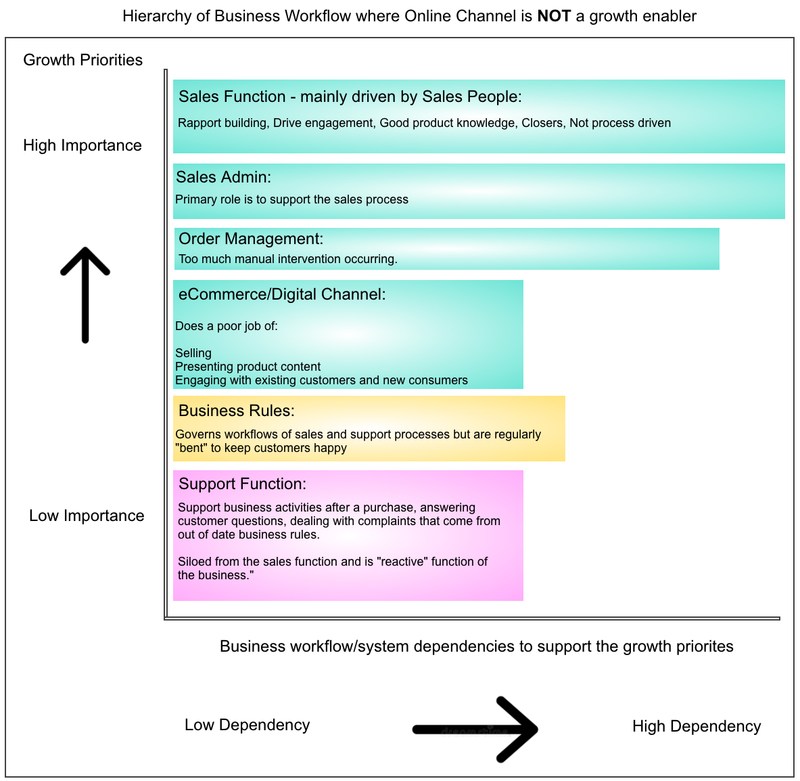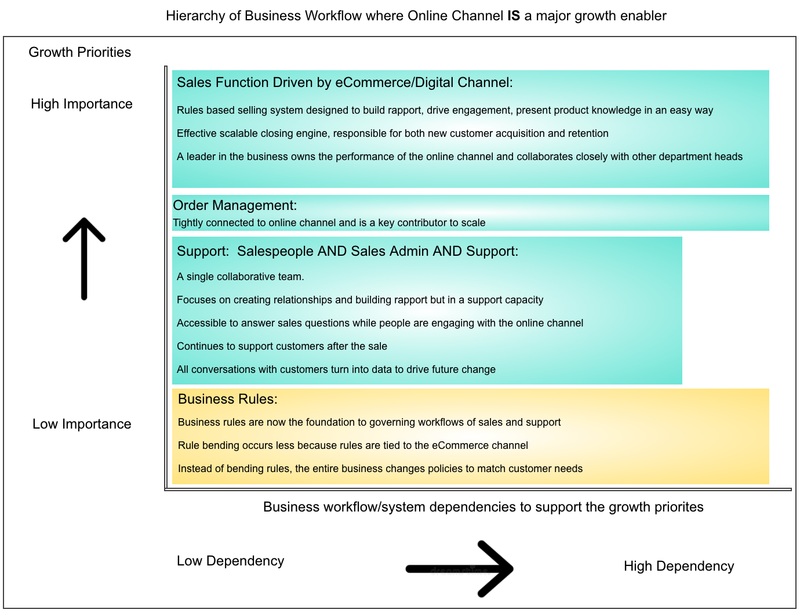
For Retailers and B2B’s to leverage the power of the online channel, evolving the eCommerce technology is one piece of a bigger puzzle.
It’s not just a channel evolution, it’s a business-wide evolution.
And believe it or not, businesses are commonly structured in a way that sets the online channel up for failure. Businesses can spend literally millions on a fully capable eCommerce channel but IF the business structure and processes, which wrap around the eCommerce channel, are not set in the right way, the business will never realise its full potential.
This article and the diagrams included are designed to illustrate both good and bad business structures and more importantly, explain what a business-wide evolution needs to look like to support the online channel and set/prepare a business for growth.
Defining "Before" and "After":
Two diagrams have been created: the “Before” and “After”.
- The bad, or “Before” diagram shows what businesses commonly look like where the online channel is underperforming.
- The good, or “After” diagram is what a business needs to look like to fully leverage the online channel to drive scalable business-wide growth.
Every business set in a "Before" business structure has been those that struggled to survive and/or grow during the Pandemic. This has been verified by countless case studies showing how business structure, processes and infrastructures were "not prepared" to appropriately support the online channel to compensate for bricks and mortar store closures.
The "Before" - business structure NOT supporting the online channel:

Vertical “Y” Axis – Growth Priorities:
The vertical axis represents how a business ranks the importance of a business function to drive growth.
Horizontal “X” Axis – Business Dependency:
The horizontal axis represents the level of dependency the business has on workflows and systems to support each function.
For example, in the “Before” graphic, the “Sales Function driven by Sales People” is the growth driver, making it a high priority (“Y” axis). The business then ranks sales workflows as a priority to support this function (“X” axis).
Sales Function Driven by Sales People:
The role of the sales function is characterized by charismatic salespeople who focus on rapport building and have the role of…
- Driving engagement and are strong “closers” but poor at the process
- Has strong product knowledge and/or has access to product collateral
- Drives sales from new customers and repeat sales from existing customers
In 2018 and 2019, research was conducted on thousands of B2B organisations which found 88% of sales came from physical salespeople. Once COVID hit the world in 2020, the sales that came from salespeople dropped from 88% to 16%.
Sales Admin:
In B2B mainly, is a dedicated team who are in place solely to support the sales process and drive the process to ensure sales are completed to preset business rules.
This team manages all follow-up questions about a sale, and is in charge of taking the money or ensuring everything is in place for fund transfers to take place as per business rules. This team ensures the commercial relationship runs to the right standard.
Order Management:
The logistics of moving products from the business to the customer is handled by a separate business function and is largely business rules-driven.
There is tension between Sales and Order Management departments due to the “over-promising” that comes from the Sales team to close sales.
Software systems supporting this function are inflexible and difficult to change and evolve.
eCommerce/Digital Channel:
The online channel does a poor job of selling, driving engagement, and presenting value-add content to help customers with decision-making processes.
The online channel is siloed from all other departments and has no individual who is fully accountable for its performance and conduct. With no controls governing conduct for the online channel, employees from different departments activate change on the online channel.
This channel is part of existing business departments (Sales/Marketing) because the business does not know where it should be positioned.
Business Rules:
Business rules govern all workflow conduct across the business.
These rules are regularly “bent” (modified) to keep customers happy. This comes from rules/policies not aligning with customer needs and get in the way of new sales or making existing customers happy.
The bulk of rule “bending” occurs within the Sales department which produces extra work and operational cost for all other departments.
“Bending” commonly comes as a result of legacy systems. Instead of replacing the system, the business forces customers to comply to outdated policies.
Support Function:
The support team handle customer complaints and suffer from the ripple effects created from out-of-date policies and the “rule bending” of the Sales team.
Because the Support function is siloed from Sales, there is no accountability for actions which increases tension and frustration.
The Support team are forced to solve problems by honoring out-of-date policies.
The wider business ignores customer feedback. The Support function suffers from the “Ambulance at the bottom of the cliff” syndrome: it's 100% reactive.
The "After" - the eCommerce channel is fully supported by business structure:

Both the X and Y axis remains unchanged as seen above in the "Before" illustration.
Sales Function Driven by eCommerce Channel:
- This channel is a rules-based selling system driving engagement, building rapport, and capturing sales at scale.
- The online channel simplifies access to product content, pricing, inventory availability, and where products can be found in physical store locations
- It’s responsible for both new customer acquisition and drives repeat buying behaviours
- All sales adhere to process and owns the process of taking money (for retail) or ensures the trade relationship is authorized (for B2B)
- The performance of this channel is owned by a member of the Executive team who actively collaborates with other department heads to drive business-wide harmony
Order Management:
Order management systems are tightly connected to the online channel and is a rules-based engine to drive scale. The order management function has a high standard of transparency across the entire workflow so the business can see every stage of a product’s progress to reach its destination (in the customer’s hands).
The order management system has the flexibility to enable the business to adapt its methods of picking, packing and delivering products to customers.
Support Function:
This becomes a collaborative team of Salespeople, Sales Admin, and Support management and continues to contribute in relationship/rapport building.
This is a holistic function with an emphasis on making employees accessible to customers throughout their “end-to-end” journey.
Support now includes a data capturing function where insights are distilled for the executive team to stimulate change and guide decision making.
This is how business rules are modified and is why the eCommerce leader must have a chair at the Executive level.
Though customer-led data comes from the bottom-up, the activation of change comes from the top-down.
Business Rules:
Business rules govern workflows and “bending of rules” occurs less.
Because business rules are now tightly linked to the eCommerce channel, instead of the business bending rules, the business addresses issues where rules need to be bent to create happy customers. This is the foundation to a customer-centric organisation.
If a “bent rule” is found to be due to a policy not being aligned with customer needs, the policy evolves/changes. The eCommerce channel is then modified to support this policy evolution.
This act of “rule automation” enables all future customers to benefit from the change and is how the Support Function scales.
This article was as tagged as Customer Service , Digital Strategy , Digital Transformation , eCommerce Consulting